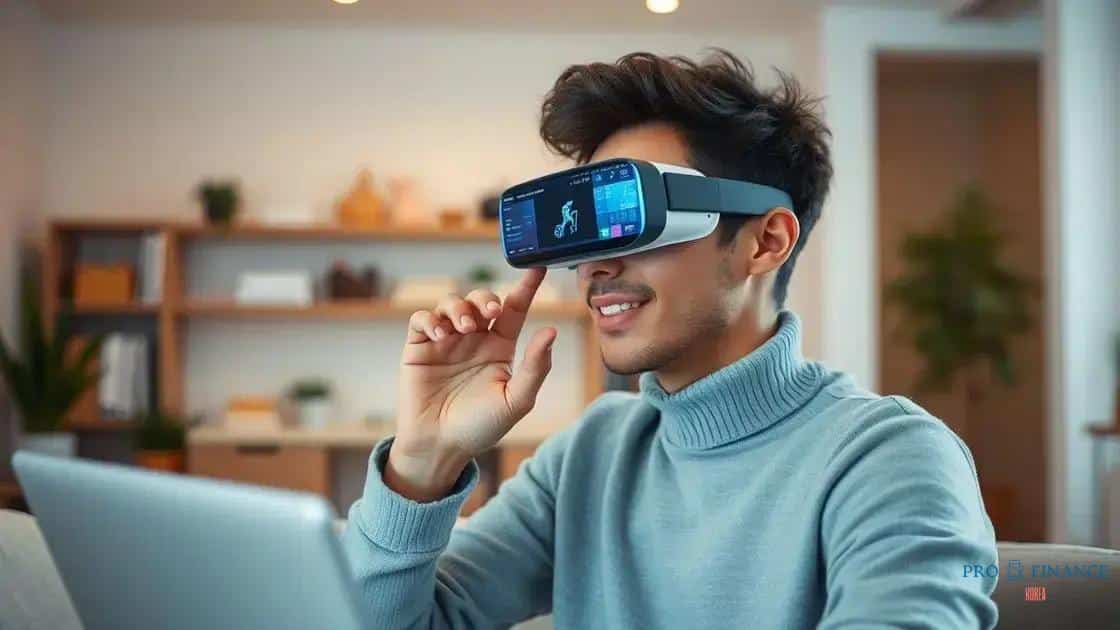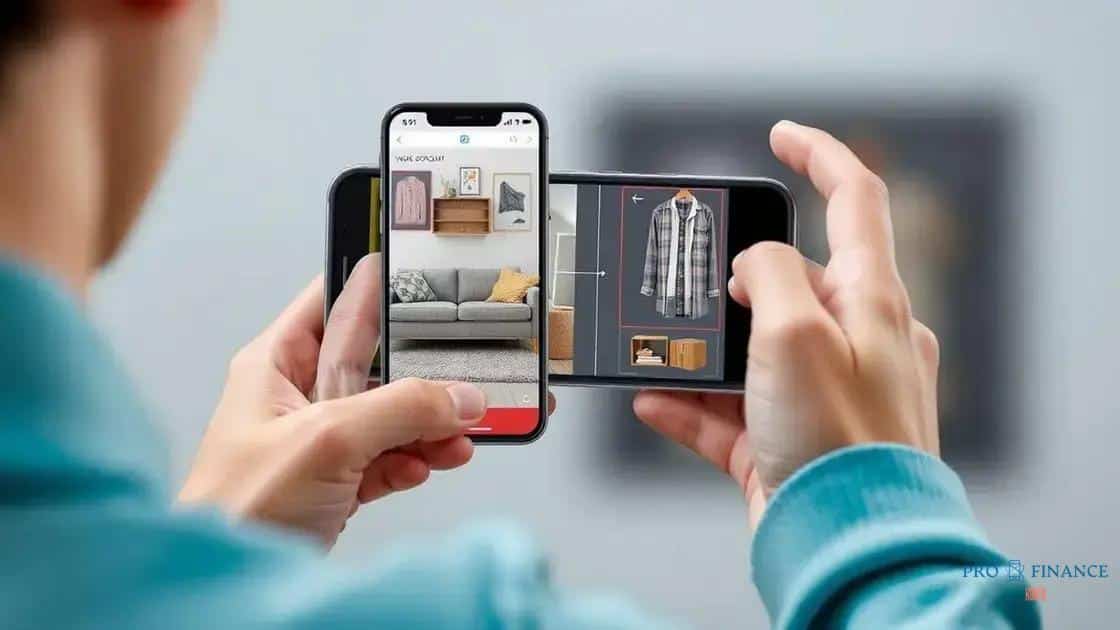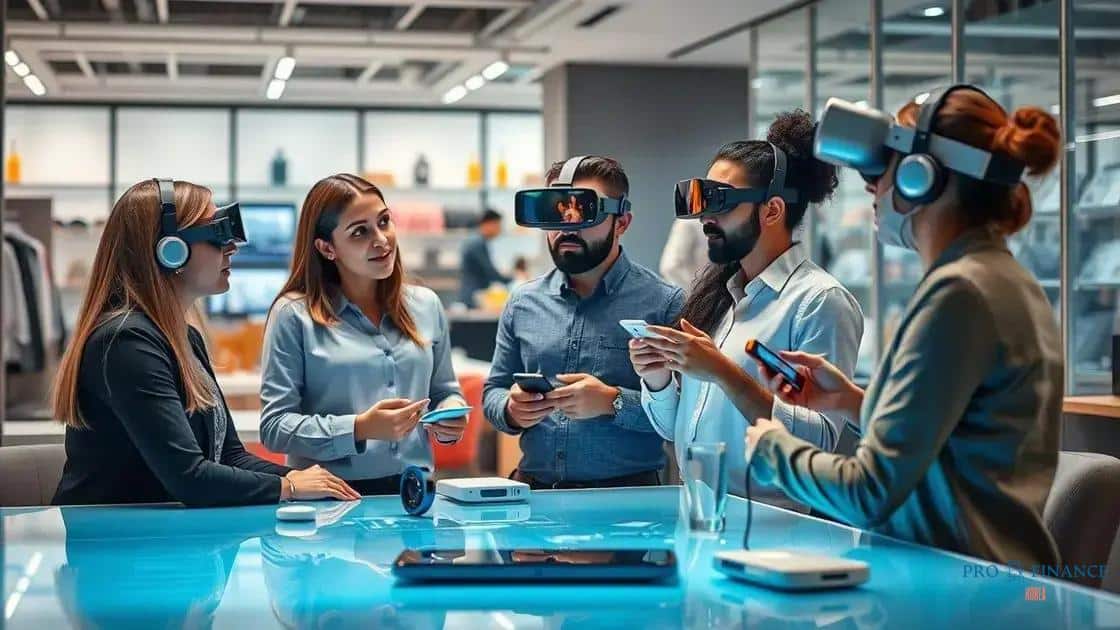The use of augmented reality in online retail experiences

The use of augmented reality in online retail experiences enhances customer engagement and satisfaction by allowing personalized visualizations, immersive interactions, and informed purchasing decisions.
The use of augmented reality in online retail experiences is changing how consumers shop. Imagine trying on clothes virtually or placing furniture in your living room before buying it. Intrigued? Let’s dive into this exciting world!
Understanding augmented reality technology
Understanding augmented reality technology is essential for grasping its impact on online retail. This technology blends digital elements with the real world to create immersive experiences. By enhancing the shopping journey, it allows customers to visualize products in their own environment.
What is Augmented Reality?
Augmented reality (AR) overlays digital information in real-time over the physical world. It’s different from virtual reality (VR), which creates completely simulated environments. With AR, users can interact with both digital and physical objects simultaneously, making it a powerful tool for online retail.
How AR Works
The functionality of augmented reality technology relies on three key components:
- Devices like smartphones or AR glasses that display the augmented content.
- Software that processes images and enhances them with digital overlays.
- Sensors and cameras to track the user’s environment and position.
This combination allows retailers to offer an interactive shopping experience. For example, imagine using your smartphone to see how a piece of furniture looks in your living room. With AR, this becomes possible, making shopping not just more engaging but also more informed.
Benefits of Understanding AR
Recognizing the capabilities of augmented reality can lead to significant advantages for retailers:
- Enhanced customer engagement throughout the shopping process.
- Higher conversion rates as customers visualize products better.
- Reduced return rates since customers can make informed decisions.
As understanding of augmented reality technology grows, so do the possibilities it offers. Retailers who embrace this technology are positioned to attract more customers and create memorable shopping experiences.
How augmented reality enhances product visualization

Augmented reality enhances product visualization by allowing customers to see how items will look and fit in their own space before making a purchase. This technology creates a rich, interactive shopping experience that can significantly influence buying decisions. Imagine being able to try on clothes or see furniture in your home without leaving your couch!
Visualizing Products in Real Time
One of the standout features of augmented reality is its ability to provide real-time visualization. Users can adjust the size and color of products right from their device, instantly seeing how it integrates into their environment. This level of interactivity builds customer confidence, leading to higher satisfaction rates.
Increased Customer Engagement
Consumers love interaction. Here are a few ways AR captures customer attention:
- Interactive features, such as rotating or zooming in on products.
- Customization options that allow users to choose colors, patterns, or styles.
- Engaging marketing campaigns that utilize AR experiences to draw consumers in.
When people engage more with the products, they are more likely to make a purchase and recommend it to others. This not only boosts sales but also leads to brand loyalty.
Reducing Uncertainty
Augmented reality plays a crucial role in reducing the uncertainty that often comes with online shopping. Many customers hesitate to buy products they cannot physically touch or see. By using AR, shoppers can validate their choices.
This is particularly useful for items like clothing, where size and fit are critical. With AR, a shopper can see how a dress fits on their own body image, minimizing the chance of returns and dissatisfaction.
Encouraging Informed Decisions
Through augmented reality, customers can make better decisions about their purchases. By visualizing products in their environment, they can consider various factors like scale and color compatibility, which traditional photos cannot provide.
As a result, augmented reality not only simplifies the buying process but also enriches it, making online shopping as seamless as possible.
The benefits of using augmented reality in retail
The benefits of using augmented reality in retail are numerous and impactful. By integrating AR into their platforms, businesses can create engaging and interactive shopping experiences that attract and retain customers. This technology not only enhances how consumers see products but also boosts overall satisfaction.
Enhanced Customer Experience
One key benefit is the improvement in customer experience. Shoppers can visualize products in their own environment, leading to a more personal connection with the item. For instance, trying out makeup virtually allows customers to see how a shade will look on them before buying. This interaction brings excitement, making shopping feel more like an adventure.
Increased Sales and Conversion Rates
Utilizing augmented reality can significantly increase sales and conversion rates. When consumers can see how a product fits into their lives, they are more likely to purchase it. Studies show that retailers using AR often experience:
- Higher engagement levels with products.
- Lower return rates due to informed buying decisions.
- Boosted sales from the interactive experience.
This immediate impact on sales is an attractive incentive for businesses to adopt AR technologies.
Cost Savings
Another advantage is the potential for cost savings. By using augmented reality, companies can reduce the need for physical samples or showrooms. Instead of having multiple product variations, AR technology allows customers to see every option digitally. This not only saves money but also minimizes waste.
Competitive Edge
Lastly, investing in augmented reality can provide retailers with a competitive edge. As more businesses adopt technology, those who embrace AR can differentiate themselves in a crowded market. By standing out, brands can attract more customers and foster loyalty.
In summary, the benefits of using augmented reality in retail are clear. From enhanced shopping experiences to increased sales, AR is a game-changer in the e-commerce landscape.
Challenges in implementing augmented reality solutions

Implementing augmented reality solutions presents several challenges that businesses must navigate carefully. While the benefits can be substantial, understanding these obstacles is key to successfully integrating AR into retail operations. From technology costs to user adoption, each aspect requires thoughtful consideration.
High Development Costs
One of the primary challenges is the high cost of development. Creating augmented reality experiences often requires significant investment in software and hardware. Businesses must allocate resources for skilled developers and designers who can create effective AR applications. This financial burden can be daunting for smaller retailers.
Technology Limitations
Another challenge is the technology itself. Not every device supports advanced AR features. Many users may have older smartphones or tablets that lack the necessary capabilities. This can limit the reach of AR applications. Additionally, maintaining compatibility across different devices and platforms can complicate development efforts.
User Adoption and Familiarity
Even with the right technology, user adoption can be slow. Many customers may be unfamiliar with using augmented reality for retail purposes. To encourage usage, businesses need to provide clear instructions and engaging tutorials. Without proper understanding, potential users may hesitate to try the new technology, reducing its effectiveness in enhancing the shopping experience.
Content Creation and Maintenance
Creating content for AR applications is another hurdle. Retailers must regularly update their AR offerings to keep them relevant and engaging. This requires ongoing investment in content development. Additionally, poorly designed AR experiences can frustrate users, pushing them away instead of attracting them.
Despite these challenges, many retailers are finding creative solutions to overcome hurdles in implementing augmented reality technologies. By addressing these issues head-on, businesses can unlock the full potential of AR in enhancing customer experiences.
Future trends in augmented reality for online shopping
The future trends in augmented reality for online shopping are exciting and full of potential. As technology advances, retailers are finding innovative ways to enhance the shopping experience. These trends are set to reshape how consumers interact with products and brands.
Personalized Shopping Experiences
One major trend is the move towards personalized shopping experiences. As AR technology evolves, retailers will be able to offer tailored recommendations based on a user’s preferences. This means shoppers can visualize products that fit their style and needs, making the buying process more engaging.
Integration of Social Media
Another emerging trend is the integration of augmented reality with social media platforms. Brands will leverage AR features within social apps, allowing users to share their AR experiences with friends. This not only enhances user engagement but also serves as a powerful marketing tool as consumers trust peer recommendations.
Virtual Showrooms and Try-Ons
Virtual showrooms are also on the rise, providing immersive ways for customers to experience products. For example, visitors could walk through a digital store and interact with items in 3D, as if they were physically present. Similarly, virtual try-ons for clothing and accessories will become increasingly sophisticated, letting shoppers see how items look on them in real-time.
- Enhanced product interactions will allow for better exploration.
- Instant feedback on fit and style will improve customer satisfaction.
- Seamless transitions between AR experiences and purchases will reduce cart abandonment.
As businesses experiment with augmented reality, advancements in AI and machine learning will further enhance user experiences. These technologies will analyze customer behavior and preferences, leading to even more personalized interactions. The combination of AR and AI will create a dynamic shopping environment that evolves with customer needs.
Mobile-First Approach
Lastly, a mobile-first approach will dominate the future of online shopping. As more consumers shop via smartphones, optimizing AR experiences for mobile devices will be essential. Brands that focus on enhancing mobile AR capabilities will likely capture a larger share of the market.
Overall, the future trends in augmented reality promise to revolutionize online shopping. By embracing these changes, retailers can create memorable experiences that captivate and retain customers.
FAQ – Frequently Asked Questions about Augmented Reality in Online Retail
What are the main benefits of using augmented reality in online shopping?
Augmented reality enhances customer experiences by providing immersive visualizations and personalized shopping options, leading to increased engagement and higher conversion rates.
What challenges do retailers face when implementing augmented reality solutions?
Retailers may encounter high development costs, technology limitations, user adoption issues, and the need for ongoing content updates.
How does augmented reality change the way customers shop online?
AR allows customers to visualize products in their own space, reducing uncertainty and helping them make informed purchasing decisions.
What future trends can we expect in augmented reality for retail?
Future trends include personalized shopping experiences, integration with social media, advanced virtual try-ons, and a stronger focus on mobile platforms.






